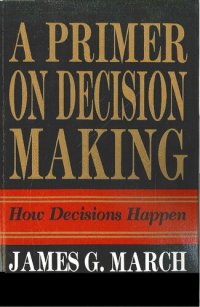
Ebook: A Primer on Decision Making, How Decisions Happen
Author: James G. March
- Year: 1994
- Publisher: The Free Press
- City: New York
- Language: English
- pdf
This book is a primer, a little compendium of ideas for thinking about how decisions happen. The ideas are not novel. They are familiar to students of decision making and are elaborated at length in the research literature. They are presented here in their starkest, least elaborate form, a first introduction to decisions. The essays in the book are concerned primarily with how decisions actually happen rather than how they ought to happen. They sometimes draw on theories that purport to say how decisions ought to be made, and the last chapter provides a few observations on how intelligence is (or is not) achieved through decision making. For the most part, however, the book sticks to a simple collection of ideas that might be useful in understanding decision making as we observe it and participate in it. Understanding any specific decision in a specific situation requires a great deal of concrete contextual knowledge-details about the historical, social, political, and economic worlds surrounding the decision and about the individuals, organizations, and institutions involved. Such details are not presented in this book. There are no stories of the rich drama of decision, no elaborations of history. The text tries to be faithful to what is known about decision making as it actually takes place, but the focus is on ideas that can be used to understand decisions generally, not on the particular details of any particular decision. Chapter 1 examines ideas of rational choice, particularly limited rationality. Chapter 2 considers ideas of identity, appropriateness, and history-dependent rules. Chapters 3 and 4 look at multiple-person decision making, decisions made in the face of inconsistency in preferences or identities. Chapter 5 treats the consequences for decision making of ambiguity in preferences, identities, and experience. Finally, Chapter 6 considers the prospects for decision engineering. Underlying these clusters of ideas are several different perspectives on decision making, with numerous variations. Students of decision making draw from all the disciplines of social science-anthropology, cognitive and decision science, economics, organization studies, political science, psychology, and sociology. As ideas from those disciplines are woven into the story of decision making, new forms of old issues are encountered: issues of reason and ignorance, of intentionality and fate, of coherence and conflict, of institutions, identities, and rules, of learning and selection, of meaning and interpretation, of preferences and obligations. Those topics will arise naturally in their places, and their details will not be anticipated here. It may, however, be useful to note four relatively deep (and not entirely independent) issues that persistently divide students of decision making: The first issue is whether decisions are to be viewed as choice-based or rule based. Do decision makers pursue a logic of consequence, making choices among alternatives by evaluating their consequences in terms of prior preferences? Or do they pursue a logic of appropriateness, fulfilling identities or roles by recognizing situations and following rules that match appropriate behavior to the situations they encounter? The second issue is whether decision making is typified more by clarity and consistency or by ambiguity and inconsistency. Arc decisions occasions in which individuals and institutions achieve coherence and reduce equivocality? Or are they occasions in which inconsistency and ambiguity are exhibited, exploited, and expanded? The third issue is whether decision making is an instrumental activity or an interpretive activity. Are decisions to be understood primarily in terms of the way they fit into a problem solving, adaptive calculus? Or are they to be understood primarily in terms of the way they fit into efforts to establish individual and social meaning? The fourth issue is whether outcomes of decision processes are seen as primarily attributable to the actions of autonomous actors or to the systemic properties of an interacting ecology. Is it possible to describe decisions as resulting from the intentions, identities, and interests of independent actors? Or is it necessary to emphasize the ways in which individual actors, organizations, and societies fit together? These issues are not resolved here, but they are exercised a bit.
Download the book A Primer on Decision Making, How Decisions Happen for free or read online
Continue reading on any device:

Last viewed books
Related books
{related-news}
Comments (0)